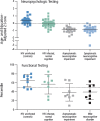HIV, aging, and cognition: emerging issues
- PMID: 23981600
- PMCID: PMC6148873
HIV, aging, and cognition: emerging issues
Abstract
The prevalence of HIV-associated neurocognitive disorder has not changed from the pre- to the potent antiretroviral therapy era, remaining at approximately 50%. In research settings, mild neurocognitive disorder (MND) and so-called asymptomatic neurocognitive impairment (ANI) are now more common than HIV-associated dementia. The diagnosis of ANI is misleading because functional deficits, when tested in a laboratory, and degree of neuropsychologic testing abnormalities are often comparable in patients with ANI and those with symptomatic MND. Age-related comorbidities increase the risk of cognitive impairment in HIV infection. In a cohort of patients aged 60 years or older with excellent antiretroviral therapy adherence, correlates to cognitive impairment were apolipoprotein (Apo) E4 genotype and a novel measure of the effectiveness of antiretroviral drugs in monocytes, the monocyte efficacy (ME) score, with trend associations for diabetes and nadir CD4+ cell count. Management of impairment includes ensuring that patients are on and adhere to antiretroviral therapy and addressing comorbidities. Switching from effective and well-tolerated antiretroviral therapy for patients with mild cognitive impairment is not routinely recommended, but this must still be addressed on a case-by-case basis. This article summarizes a presentation by Victor G. Valcour, MD, at the IAS-USA continuing education program held in Atlanta, Georgia, in April 2013.
Conflict of interest statement
Financial Affiliations: Dr Valcour has no relevant financial affiliations to disclose.
Figures




References
-
- Ellis R, Langford D, Masliah E. HIV and antiretroviral therapy in the brain: neuronal injury and repair. Nat Rev Neurosci. 2007;8(1):33-44. - PubMed
-
- Grant P, Komarow L, Sereti I, et al. Risk factor analyses for immune reconstitution inflammatory syndrome and mortality during a randomized trial of early versus deferred ART in the setting of acute opportunistic infections: ACTG A5164 [Abstract 775]. 16th Conference on Retroviruses and Opportunistic Infections (CROI). February 8-11, 2009; Montreal, Canada.
Publication types
MeSH terms
LinkOut - more resources
Full Text Sources
Medical
Research Materials
Miscellaneous
